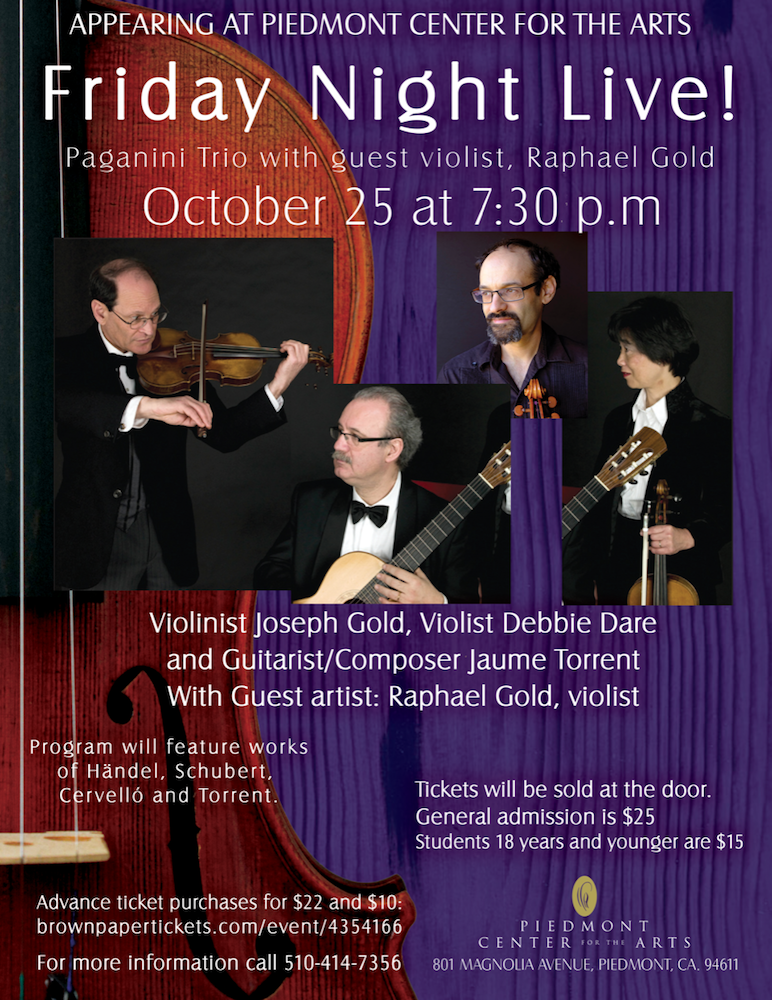Energy and expertise combine in a lively program with the return of the Paganini Trio to the Piedmont Center for the Arts on Friday, October 25. Ensemble guitarist Jaume Torrent, violist Debbie Dare, and violinist Joseph Gold present a broad-sweeping program featuring the works of Handel, Cervelló, Schubert and a U.S. premier of a new composition by Torrent. In a program highlight, Piedmont violist Raphael Gold will make his debut with the trio, joining Torrent to perform Schubert’s “Arpeggione” Sonata in A minor, D. 821.
The mixed repertoire suggests and highlights the trio’s particular skill for capturing the character and style of each composer’s work. Comfortable with the rigor and restraint demanded by Handel, the trio dexterously pivots to the intricacies of Cervelló and the mood-shifting poetry and quiet power of Schubert.
Pro Musica String Quartet founder, violist and violinist Dare formed the Paganini Trio. Originally premiering in 2000 in Vienna, the city of Paganini, among other composers, the trio enjoyed instant, international success. Extensive international and national tours followed; most recently bringing them as featured artists to the summertime Narnia International Music Festival in Italy. Dare performs with Bay Area orchestras and maintains a busy teaching career along with trio appearances.
Gold is recognized for vivid interpretations of well- and lesser-known, even obscure, nineteenth-century works for violin composed by Paganini and Sarasate, among other composers of the era. He began studying violin at age 8, eventually becoming the student of the great violinist Jascha Heifetz. An internationally-renowned musicologist, Gold’s deep knowledge of the canon and shared stories recalling performances on highly valued violins bring special value during the trio’s concerts and post-show receptions.
Barcelona native Torrent’s brilliant technique and artistic sensitivity has led to critical accolades and success performing on stages worldwide. Presenting works by Cervelló, H. Villa-Lobos, and many more, he shares signature methodology and technique with students at universities and workshops. As a composer, his works include pieces for chamber ensemble, orchestra and solo guitar.
The selection of Schubert’s sonata provides unique opportunity to appreciate the trio’s strengths and the approximately 20-minute, three-movement work’s delicate melodies and powerful passages. Schubert, when he composed the work, was ill with syphilis, the condition that would end his life four years later. The sonata’s mood shifts dramatically throughout; from major to minor keys in the first movement to lengthy, lush legato lines in the adagio to rapid, rolling arpeggios in the third movement. Heard in an intimate setting without digital enhancement, it is often an audience favorite, appreciated for its fragile beauty and expressive range.
Lovers of music history might take interest in the arpeggione. The fretted, six-stringed instrument introduced in 1823 and for which the sonata was originally composed, was already out of use by the time Schubert wrote the sonata in 1824. In contemporary times, Schubert’s sonata is most often transcribed for cello or guitar; only rarely is the original instrument used in performance.
